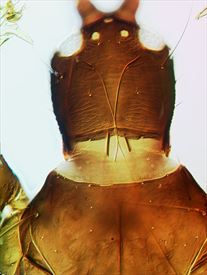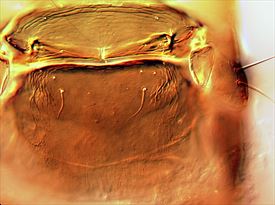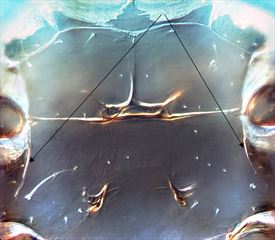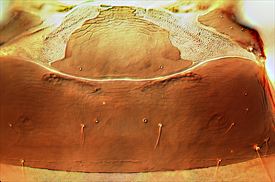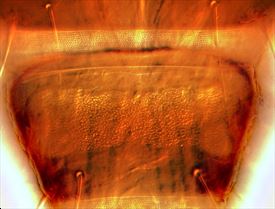Distinguishing features
Female fully winged or micropterous Body brown; yellow on apex of antennal segment II, segment III, basal half of IV–VI, tarsi, and tibiae; fore wings shaded, mottled on distal half; major setae pale. Head expanded behind compound eyes; cheeks with at least 1 pair of small, stout setae; compound eyes similar in size dorsally and ventrally; postocular setae long, acute; maxillary stylets close together, retracted to compound eyes. Antennal segment III with tranverse lines of sculpture in basal third; sense cones short, segment III with 3, segment IV with 4; segment VIII constricted at base. Pronotum with major setae long, acute, anteromarginal setae shortest; basantra absent. Mesopresternum divided into 3 small sclerites; metathoracic sternopleural sutures present. Metanotum with 1 pair of median setae in anterior half, and 2 smaller pairs near anterior margin. Fore tarsal tooth present. Fore wings with 7–14 duplicated cilia; major sub-basal setae finely pointed, S1 and S2, the longest. Pelta irregularly 'D'-shaped, faintly reticulate anteriorly; posterior margin lying very close to concave anterior margin of tergite II; tergites II–VII each with 2 pairs of wing-retaining setae, curved on II but otherwise sigmoid; tergite IX posteromarginal setae S1 almost as long as tube, acute. Female microptera with compound eyes and ocelli smaller; antennal segment III often with 2 sense cones; mesonotum and metanotum transverse; fore wing lobe bearing 2 pairs of acute setae; tergites III–VII with anterior pair of wing-retaining setae curved, not sigmoid.
Male microptera. Similar to female but smaller; sternite VIII with a broad, transverse pore plate not extending to lateral margins; sternites III–VII with a pair of specialised sculptured areas laterally. Large males with fore tarsal tooth enlarged, fore femora swollen.
Related species
The genus Hoplothrips comprises about 130 species worldwide, of which 7 are recorded from New Zealand. Several of these appear to be endemic to this country, but corticis is from the Northern Hemisphere and orientalis is probably from Asia. H. corticis has the pelta posterolateral margins close to the anterior margin of the second tergite.
Biological data
In New Zealand, this fungus-feeding species has been found on dead branches of Pinus radiata and of apple trees.
Distribution data
This species appears to be widespread across the Northern Hemisphere, but is established in New Zealand (SD, NN, BR).
Family name
PHLAEOTHRIPIDAE, PHLAEOTHRIPINAE
Species name
Hoplothrips corticis (De Geer)
Original name and synonyms
Thrips corticis De Geer, 1773: 11
Trichothrips copiosa Uzel, 1895: 252
Trichothrips aceris Karny, 1913: 125
References
Mound LA & Walker AK (1986) Tubulifera (Insecta: Thysanoptera). Fauna of New Zealand 10: 1–140.

